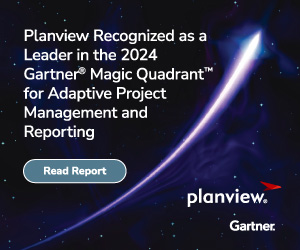
You know the saying: The only constant is change.
It’s true for all disciplines and describes the project portfolio management (PPM) market for several reasons. Consider these changes faced by PMOs in recent years:
- The call to infuse agility and become a modern PMO.
- The market’s landmark evolution in 2020, which bifurcated PPM to support strategic portfolio management and adaptive project management.
- The pandemic’s impact on the labor market and the rise in burnout.
- The economic headwinds and uncertainty driving an increased focus on outcomes and productivity.
Why is the project portfolio management market continuously evolving? In short, it’s because the nature of business and the technologies that support the market are constantly transforming.
The pressure to evolve is mounting for the PMO, which needs to adapt to new digital strategies – and more strategic, product, or initiative portfolios – while bridging traditional practices.
That challenge will only intensify. In fact, according to Gartner®1:
- By 2025, 70% of digital investments will fail to deliver the expected business outcomes due to the absence of a strategic portfolio management approach.
- By 2025, more than 60% of strategic portfolio leaders will transition from overseeing delivery execution to overseeing value realization as their primary objective.
As the evolution continues, both your PMO and your organization must not only stay abreast of changes but act in anticipation of them. The more flexible you are, the better positioned you will be to face whatever may come at the pace of change.
Where is the PPM Market Headed?
As a Leader in the September 2023 Gartner Magic Quadrant™ for Adaptive Project Management and Reporting and April 2023 Gartner Magic Quadrant for Strategic Portfolio Management, we aim to stay closely connected to the changing tides of the market and the evolving needs of our customers.
Based on our conversations with customers and an analysis of current project portfolio management trends, we’ve identified three predictions that will transform project portfolio management into strategic portfolio management in the coming years.
AI will surface operational intelligence that unifies the organization and drives strategy.
AI will play an important role in nearly every technology, and its impact on portfolio management will be profound. We predict solutions will leverage AI to move beyond managing projects and into the role of strategically steering organizations forward. This will include:
- Dramatically enhancing the customer experience through AI-powered assistants that align users, using a natural language interface, to provide direct answers to queries. This will guide all teams toward more targeted conversations on risk analysis, resource limitations, and on-time delivery.
- Using data collected from every corner of the organization to simulate and evaluate various scenarios, enabling strategic, data-driven decision making that ensures the best possible outcomes.
- Leveraging predictive AI analytics to power early warning systems that alert companies when projects are at risk of failure through every stage of the process—from planning to delivery—and enabling companies to act before an issue develops by assigning new resources, reallocating budgets, or taking other necessary steps.
AI will deepen operational intelligence and drive strategic decision making.
This will make it easier for teams to collaborate. At the same time, it will provide insight into real-time risks and on-time delivery that aligns with your company’s strategy and, therefore, enables the executive teams to drive strategy.
Tomorrow’s portfolio management solutions will deconstruct silos and connect functional teams across the organization.
Next-generation portfolio management platforms must respond to the needs of virtually every stakeholder in your organization:
- Executives must have access to real-time, actionable data regarding the health and status of their business initiatives to drive faster and more accurate decisions.
- PMOs must be able to provide direction to various areas within your organization to de-risk strategic bets.
- Organizations must establish processes and governance policies that increase efficiency and enable productivity but that also allow for self-direction.
- Teams must have a common language to facilitate connected work and break down silos and other barriers to communication.
How will the market respond?
The market will see an evolution of work method-agnostic connected networks that integrate multiple systems and break down data silos. This type of platform will mitigate communication barriers, provide end-to-end visibility, facilitate connected work, easily link people to customers and strategy to delivery, and allow teams to use the tools that make them productive.
The platform will also leverage the power of generative AI to support your investment strategies, track project progress and results, and enhance the management of your digital products and experiences.
Only when your teams and tools are connected and aligned with shared objectives, shared metrics, and key results can you yield better decisions and deliver better outcomes.
Cloud deployment will accelerate digital transformation.
According to Gartner2, by 2025, 80% of enterprises will have adopted multiple public cloud infrastructure as a service (IaaS) offerings — including multiple K8s offerings.
We agree. Even where sovereignty-related or regional constraints may today require on-premises or hybrid solutions, we anticipate barriers to cloud-based solutions will be systematically removed.
As a result, cloud-based solutions will continue to gain market share due to the many benefits they’ve become known for, including:
- Scalability and guaranteed uptime
- Reduced costs
- Minimal in-house expertise requirements for management and administration
The benefits of cloud-based tools will be too great to ignore, especially in the midst of an economic downturn. Moreover, a cloud-based approach will breathe new life (and urgency) into the digital transformation underway for the last decade.
Change Breeds Opportunity
As portfolio management evolves, it will increasingly act as a key strategic driver across your business. This is an important opportunity for your organization, and particularly for your PMO, which stands to gain significant leadership authority in the transition.
By embracing this new technology, PMOs will be positioned to navigate disruption and make the project-to-product shift. This will elevate you to a new role – one that shepherds the delivery of value and outcomes over activities and outputs.
The key is to understand the opportunity and to arm yourself with the tools required to thrive in the next paradigm. Planview can help. To read more about Planview’s approach, download the 2023 Gartner® Magic Quadrant™ for Adaptive Project Management and Reporting.
1Gartner, Top Trends for Strategic Portfolio Leaders for 2023, Kevin Rose, Rachel Longhurst, et al., 14 August 2023.
2Gartner, Market Guide for Cloud-Native Application Protection Platforms, Neil MacDonald, Charlie Winckless, Dale Koeppen, 14 March 2023.
GARTNER is a registered trademark and service mark of Gartner, Inc. and/or its affiliates in the U.S. and internationally, and MAGIC QUADRANT is a registered trademark of Gartner, Inc. and/or its affiliates and are used herein with permission. All rights reserved.
Gartner does not endorse any vendor, product or service depicted in its research publications, and does not advise technology users to select only those vendors with the highest ratings or other designation. Gartner research publications consist of the opinions of Gartner’s research organization and should not be construed as statements of fact. Gartner disclaims all warranties, expressed or implied, with respect to this research, including any warranties of merchantability or fitness for a particular purpose.




